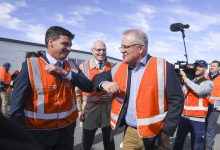Our new opposition leader, Peter Dutton, and the former minister for emission reduction, Angus Taylor, have been blitzing the media trying to rewrite history to spread the blame for our energy and climate mess. But the world is a weird place.
In a perverse way, the Abbott and Morrison governments can take much of the credit for the progress in renewable energy over the past decade, grossly inadequate as it was.
First, the Abbott government’s efforts to kill off the Renewable Energy Target did hold back investment for a while. But once a lower target was agreed after a long delay, few imagined that the renewable energy industry could achieve even that smaller target.
So the price of Large Generation Certificates rocketed from a downward trend of around $30 to around $85, and energy retailers rushed to buy up LGCs in what they believed would be a tightening market.
Investors rushed to build renewable energy capacity, and captured economies of scale and momentum through innovation and competition.
The unplanned closure of the Hazelwood brown coal power plant at short notice, which was possible because of the Coalition’s lack of clear policy and enforcement of effective market rules, pushed up electricity prices, adding to the incentive to invest in renewables.
Malcolm Turnbull’s time as Prime Minister cemented renewable energy action by states, business and communities. His ‘deal with the devil’ to win the Coalition leadership reinforced perceptions that our national government was enmeshed in internal battles at the expense of Australians.
This was further reinforced by the failure to implement the National Energy Guarantee, which was widely seen as the absolute minimum that was needed.
The tendency of Angus Taylor, Minister for the bizarrely named Energy and Emissions Reduction portfolio, to abuse and blame state governments for any blemish in their energy policy drove state and territory governments to go hard on renewable energy policy.
Taylor knew that if ‘the lights went out’ powerful media interests would amplify his macho messages and undermine voter confidence.
Prime ministers and other Coalition politicians would join in the chorus. This made energy policy a major cabinet issue for state governments: they had to drive action and aggressively publicise what they were doing. And make sure what they did worked.
The Coalition government’s efforts to undermine energy efficiency improvement added to the focus on renewables, by allowing energy demand and waste to grow.
Energy efficiency programs were killed off and starved of resources and leadership. After a decade of zero or negative growth in electricity and retail gas demand, growth re-emerged.
The Abbott government’s 2014 closure of our world-leading industrial energy efficiency program undermined motivation for most government intervention in business activity.
The Energy Efficiency Opportunities program was saving over $320 million annually at a cost of minus $95 per tonne of avoided emissions, and was transforming business culture.
Our appliance efficiency scheme, which is saving millions of tonnes of emissions at a cost of minus $200 per tonne of avoided emissions and cutting household energy bills, has been starved of resources and ambition. Implementation of stronger building energy efficiency measures has stalled.
While all this was happening at the political level, Australian communities realised they had to take things into their own hands.
Supported by state governments, they enthusiastically installed enormous amounts of rooftop solar and set up numerous community action groups to pressure councils, state governments and businesses to act, and drove innovative community energy projects.
Would all of these remarkable developments have happened without an inept and anti-renewables national government? I suspect they would not.
We needed radical transformation. A “competent government,” still influenced by powerful fossil fuel and incumbent electricity industry interests, may have done much less, while state governments would not have been exposed to as much pressure and the community was lulled into inaction by the belief that the government (supported by media management) was managing the climate and energy issues.
In any case, we must confront today’s realities, not debate what might have happened. The recent energy crisis is focusing minds, and reinforcing the messages sent by our tragic bushfires and floods, and the increasingly strident statements by scientists, the UN and energy experts such as the International Energy Agency. Humanity is in deep trouble, and we must act aggressively and effectively.
We are fortunate that there is now political momentum at a national level to take effective action. The Labor government’s tenuous grip on power, the focus of the Greens and independents on serious climate action, and the lived experience of failing fossil fuel energy systems will hopefully deliver urgently needed change.
Sadly, though, I remain pessimistic about the possibility that ‘the first fuel’, energy efficiency, will receive appropriate attention.
Alan Pears AM has worked on clean energy and climate policy for several decades. His work spans all sectors of the economy, ranging from practical site-level projects to program development and implementation, policy analysis and education. He is a Senior Industry Fellow at RMIT University and a Fellow at the University of Melbourne’s Climate and Energy College










